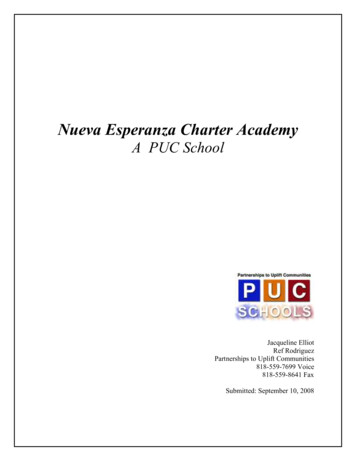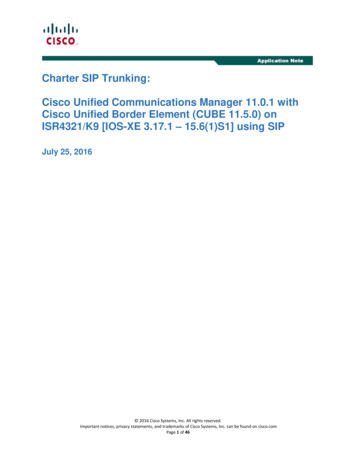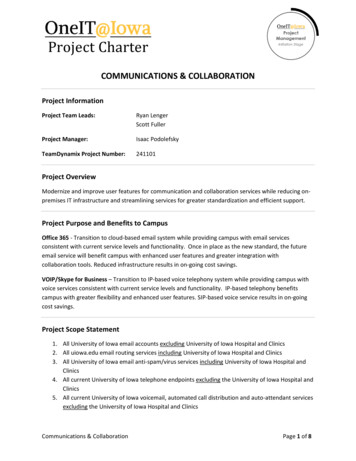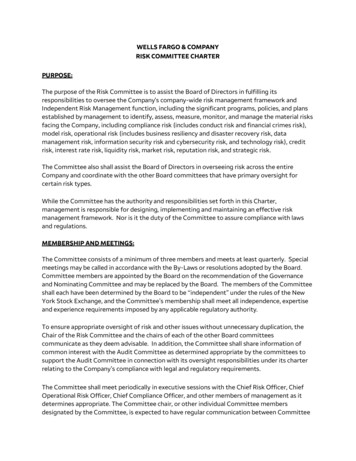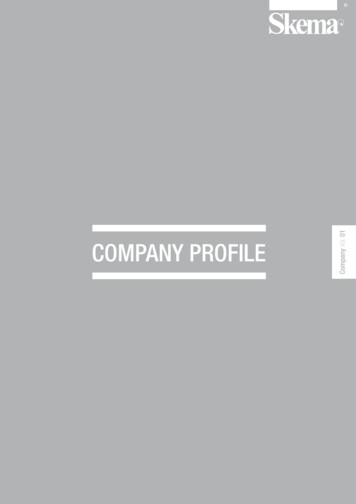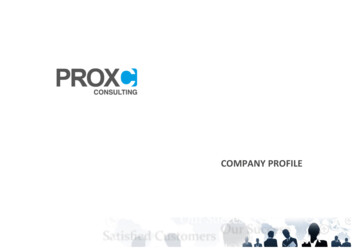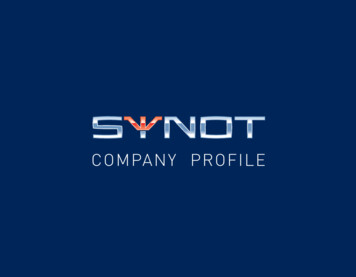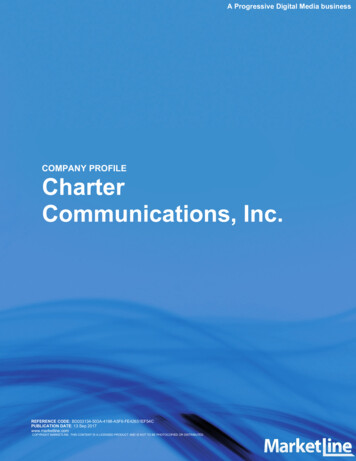
Transcription
A Progressive Digital Media businessCOMPANY PROFILECharterCommunications, Inc.REFERENCE CODE: BD033134-503A-4198-A5F6-FE42651EF54CPUBLICATION DATE: 13 Sep 2017www.marketline.comCOPYRIGHT MARKETLINE. THIS CONTENT IS A LICENSED PRODUCT AND IS NOT TO BE PHOTOCOPIED OR DISTRIBUTED
Charter Communications, Inc.TABLE OF CONTENTSTABLE OF CONTENTSCompany Overview .3Key Facts . 3SWOT Analysis .4Charter Communications, Inc. MarketLinePage 2
Charter Communications, Inc.Company OverviewCompany OverviewCOMPANY OVERVIEWCharter Communications Inc. (Charter or "the company") is a cable service provider offeringentertainment, information and communications solutions to residential and commercial customers. Thecompany primarily operates in the US. Charter headquartered in Stamford, Connecticut, the US.The company reported revenues of (US Dollars) US 29,003 million for the fiscal year ended December2016 (FY2016), compared to a revenue of US 9,754 million in FY2015. In FY2016, the company’soperating margin was 11.2%, compared to an operating margin of 10.1% in FY2015. The net profit of thecompany was US 3,522 million in FY2016, compared to a net loss of US 271 million in FY2015.The company reported revenues of US 10,164 million for the first quarter ended March 2017, a decreaseof 1.1% over the previous quarter.Key FactsKEY FACTSHead OfficeCharter Communications, Inc.12405 Powerscourt DriveSt. LouisMissouriSt. LouisMissouriUSAPhone1 314 9650555Fax1 302 6365454Web Addresswww.charter.comRevenue / turnover (USD Mn)29,003.0Financial Year EndDecemberEmployees91,500NASDAQ TickerCHTRCharter Communications, Inc. MarketLinePage 3
Charter Communications, Inc.SWOT AnalysisSWOT AnalysisSWOT ANALYSISCharter Communications Inc. (Charter or "the company") is a cable service provider offeringentertainment, information and communications solutions to residential and commercial customers.Established market presence and growing customer base of the company ensure stable revenues in thecoming years. However the intense competition may reduce the company's market share and affect itsrevenues in the future.StrengthWeaknessEstablished market presence and growing customerbaseExtensive network technology and customer premiseequipmentDiverse revenue sourcesSubstantial debt could limit growth prospectsConcentrated operationsOpportunityThreatIncreasing demand for bundling services offers growth Intense competitionopportunityIncreasing programming costsRobust growth in on-demand services marketStrategic merger with Time Warner Cable and BrightHouse NetworksStrengthEstablished market presence and growing customer baseThe company has established market presence and wide customer base. The company is the fourthlargest cable provider in the US with its services passing through 49.2 million passings. Further thecompany also has a wide customer base. Charter had a customer base of approximately 26.2 millionresidential and small and medium business customers as on December 31, 2016. The company hadapproximately 16.8 million residential video customers; 21.4 million residential internet customers; 10.3million residential voice customers; and 2.4 million commercial primary service units' as on December 31,2016. The established market presence and growth in the customer base ensures stable revenues in thecoming years. In addition, the strong customer base also allows the company to cross-sell and up-sell itsproducts and services generating additional revenues.Extensive network technology and customer premise equipmentThe company has extensive network technology and customer premise equipment. Charter's networkincludes three components: the national backbone, regional/metro networks and the "last-mile" network.This national backbone provides connectivity from the regional demarcation points to nationallyCharter Communications, Inc. MarketLinePage 4
Charter Communications, Inc.SWOT Analysiscentralized content, connectivity and services. In addition, the regional/metro network componentsprovide connectivity between the regional demarcation points and headends within a specific geographicarea and enable the delivery of content and services between these network components. Charter's lastmile network utilizes a hybrid fiber coaxial cable (HFC) architecture, which combines the use of fiber opticcable with coaxial cable. In most systems, the company delivers its signals through fiber optic cable fromthe headend to a group of nodes, and use coaxial cable to deliver the signal from individual nodes to thehomes served by that node. Such hybrid network design provides high capacity and signal quality. Inaddition, it provides two-way signal capabilities for the support of interactive services. Approximately 98%of Charter's estimated passings are served by systems that have bandwidth of 750 megahertz or greaterand 99% was two-way activated as on December 31, 2016. This provides the company's uniquecompetitive advantage as this bandwidth capacity enables Charter to offer digital television, internetservices, voice services and other advanced video services.Diverse revenue sourcesThe company generates revenues through diverse sources. The company operates through six productlines out of which video product line generated 41.3% of the total revenues during FY2016. This wasfollowed by internet (32%), commercial (13.5%) voice (6.9%), advertising sales (4.3%) and other (2.1%).The diverse revenue sources allow the company to offset the weak performance of a segment by thestrong performance of another segment. For instance in FY2016, the company's video, internet, andcommercial product lines showed significant revenue growth. The video product lines recorded revenuesof 11,967 million, an increase of 160.9% over FY2015. The internet product lines recorded revenues of 9,272 million in FY2016, an increase of 208.8% over FY2015. Further, the commercial product linesrecorded revenues of 3,909 million in FY2016, an increase of 246.9% over FY2015. These allowed thecompany to offset the weak performance of the voice product line. Diverse revenue sources reducebusiness risks and ensure stable revenues in the coming years.WeaknessSubstantial debt could limit growth prospectsCharter is highly leveraged. In FY2016, the company's total debt was 61,747 million. The heavy longterm debt could force the company to allocate a considerable portion of its cash flow from operationstowards servicing its debt. It will limit the company's ability to obtain additional financing and Chartermight suffer competitive disadvantage in comparison to peers with low debt. As a consequence of suchheavy debt, Charter incurred interest expense of 2,499 million, which impacted the company's net profitsand margins. Substantial debt limits the company's flexibility to plan for, or react to, changes in itsbusiness and the industry in which it operates.Concentrated operationsThe company's operations are highly concentrated. Charter is highly dependent on the US market formajority of its revenues. Substantially all of its revenues are from customers located in the US.Overdependence on one single geographic region makes it susceptible to changes associated with theeconomic and political situation of the country. Concentrated operations could also make CharterCharter Communications, Inc. MarketLinePage 5
Charter Communications, Inc.SWOT Analysisuncompetitive against rivals who have globally diversified operations.OpportunityIncreasing demand for bundling services offers growth opportunityOver the last few years, there has been an increase in the customer adoption of bundled services. Thetriple play services where the wireline or wireless carriers offers video, telephone and broadband internetin a single bundle is gaining popularity in recent times as customers feel bundled offerings reduce theoverall spending. Further there is also an increase in the adoption of quad-play services which alsoincludes wireless telephone services in addition to the triple play services. According to industryestimates, triple play subscription revenues are expected to reach 144 billion in 2018. Further, triple playsubscribers are expected to reach 333 million subscribers by 2018. Also, the US is expected to accountfor 40% of the global triple play revenues by 2018.Charter offers video, internet and voice services often in a bundle of two or more services. The company'sbundled services are made available to about 98% of the company's customers and approximately 61%of the company's customers subscribe to a bundle of services. This indicates that Charter was able toeffectively tap into the customer base with the highly penetrated bundled services. In addition, thecompany launched Charter Spectrum that offers over 200 HD channels, faster internet speeds and voiceservice. This service is expected to enhance the company's market share in both residential and businessmarkets.The company's robust portfolio of bundled services allows it to take advantage of the increased customeradoption of bundled services, enhancing revenues and market share.Robust growth in on-demand services marketThe market for video on-demand (VoD) has been growing robustly over the years and is expected togrow further. According to industry estimates, the global VoD market accounted for 33.3 billion in 2015and is expected to expand at a compound annual growth rate (CAGR) of 9.3% from 2016 to 2024 toreach 73.9 billion by the end of the forecast period. Further, North America is expected to be the biggestmarket in terms of revenue contribution during the forecast period, with 40% share in the global video ondemand market in 2015. The strong growth is attributed to a wide range of premium and exclusivecontent offered by on-demand service providers.Charter offers video on demand service which allows customers to select from 10,000 or more titles atany time. The company’s video on demand services includes standard definition, HD and threedimensional (3D) content. Charter also offers video on demand services based on subscription. Therobust growth in on demand market is expected to provide new revenue generation opportunities for thecompany, diversifying its business risk and boosting margins.Strategic merger with Time Warner Cable and Bright House NetworksThe strategic merger of the company with Time Warner Cable and Bright House Networks is expected toCharter Communications, Inc. MarketLinePage 6
Charter Communications, Inc.SWOT Analysisprovide significant scale efficiencies and boost topline performance. In May 2016, Charter completed itsmerger with Time Warner Cable, one of the largest cable operators in the US, in a transaction valued at 79 billion. In addition, Charter and Advance/Newhouse Partnership amended their existing agreement,whereby Charter agreed to acquire cable systems operator Bright House Networks. The combination ofCharter, Time Warner Cable and Bright House is expected to create a leading broadband services andtechnology company. The announced transactions are expected to drive investment into the combinedentity's advanced broadband network, allow for wider deployment of new competitive facilities based WiFinetworks in public places, and the footprint expansion of optical networks to serve the large marketplaceof small and medium sized businesses. This would result in faster broadband speeds, better videoproducts, including more high definition channels, more affordable phone service and more competition,for consumers and businesses. Further, the scale of the new entity would also result in greater productinnovation, bringing new and advanced services to consumers and businesses, including Charter'sSpectrum Guide and World Box and other product innovations.ThreatIntense competitionThe company faces intense competition in the marketplace based on price, service offerings, and servicereliability. The company's major competitors include direct broadcast satellite (DBS) providers andtelephone companies and utilities. It competes with telephone companies, such as AT&T and VerizonCommunications, which offer video and other services. The company experienced customer losses inareas where AT&T and Verizon Communications offer video services. The company also competes withdigital subscriber line (DSL) service providers including AT&T and Verizon. Moreover, thetelecommunications and voice services industry is highly competitive and includes competitors withgreater financial and personnel resources, strong brand name recognition, and long-standingrelationships with regulatory authorities and customers. Further, consolidations among the company'scompetitors have resulted in providers capable of offering cable television, internet, and telephoneservices in direct competition with the company.The company also faces increasing competition for the leisure and entertainment time of consumers. Itsbusiness competes with all other sources of entertainment and information delivery, including broadcasttelevision, movies, live events, radio broadcasts, home video products, console games, print media, andthe internet. Further, due to consumer electronic innovations, content owners are allowing consumers towatch internet delivered content on televisions, personal computers, tablets, gaming boxes connected totelevisions and mobile devices, some without charging a fee to access the content. Furthermore,technological advancements, such as video on demand, new video formats, and internet streaming anddownloading, have increased the number of entertainment and information delivery choices available toconsumers, and intensified the challenges posed by audience fragmentation.Intense competition may reduce the company's market share and affect the company's revenues in thefuture.Increasing programming costsCharter Communications, Inc. MarketLinePage 7
Charter Communications, Inc.SWOT AnalysisProgramming costs are the biggest outlay of expense for a cable company. Programming costs areexpected to increase at a faster rate in the future than in prior years. The programming costs areexpected to increase further due to various factors, including amounts paid for retransmission consent,annual increases imposed by programmers with additional selling power as a result of mediaconsolidation, incremental programming, including new sports services, out-of-home or non-linearprogramming for on-line and on-demand platforms. Further, the company has programming contracts thatare expected to expire by the end of FY2017. The programming costs of the company wereapproximately 7 billion, 2.7 billion and 2.5 billion representing 38%, 42% and 41% operating costs andexpenses during FY2016, FY2015 and FY2014, respectively.Over the past several years, increase in video service rate has not offset increasing programming costs,and with the impact of increasing competition and other marketplace factors, Charter does not expectthem to do so in the foreseeable future. In addition, the company's inability to fully pass these increasingprogramming costs on to the video customers is expected to have an adverse impact on cash flow andoperating margins.Charter Communications, Inc. MarketLinePage 8
Copyright of Charter Communications, Inc. SWOT Analysis is the property of MarketLine, aProgressive Digital Media business and its content may not be copied or emailed to multiplesites or posted to a listserv without the copyright holder's express written permission.However, users may print, download, or email articles for individual use.
Charter Communications Inc. (Charter or "the company") is a cable service provider offering entertainment, information and communications solutions to residential and commercial customers. Established market presence and growing c

